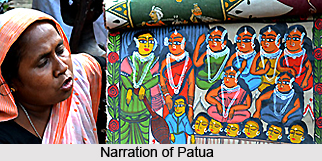 Patua song belongs to a social group called patua that was brought to light during the nineteenth century at various levels. Two major sections of this group belong to Tamluk, Kalighat, Triveni, Kandi, Katowa and Birbhum-Bankura districts of West Bengal. Murshidabad Kalna is another group living in some rural pockets. In Odhisa, Patua Jatra is a popular folk-cult group distinct from Bengal groups.
Patua song belongs to a social group called patua that was brought to light during the nineteenth century at various levels. Two major sections of this group belong to Tamluk, Kalighat, Triveni, Kandi, Katowa and Birbhum-Bankura districts of West Bengal. Murshidabad Kalna is another group living in some rural pockets. In Odhisa, Patua Jatra is a popular folk-cult group distinct from Bengal groups.
Patuas
Apparently, Patuas of the two states are people of a social level having no rights of entry into Hindu temples. They are not Muslims. There is a society in which Hindu and Muslim ways of life have been integrated in a peculiar way. Marriages of Bengali Putuas are celebrated by the Muslim Kazi, but female folks use vermilion and a bangle known as sankha. They compose songs corresponding to their paintings on Pat clothes or on hand-made papers serialized in a long chain of sixteen to twenty-five metres in length, if not more. In width the Pat is only one foot or so.
Subjects of Patua Songs
Subject matters are miscellaneous. Narratives on subjects like Lord Krishna, Lord Shiva, Parvati, Goddess Durga, Sri Gauranga, various episodes of the Ramayana, Goddess Laksmi, Chandi, Mansamangal, etc., are covered in a series of paintings on a Pat which is wrapped round a stick with another piece of stick fixed up at the other end. In the nineteenth century, some popular stories of lower Bengal, such as Gazi`s encounter with tigers and the pirates-at-large, were also covered.
Performance of Patua Songs
Patuas generally come out with their Pats, open them before the congregation of rural listeners, and then start singing the stories pointed on them. Sticks are used to indicate items. They sing in the style of simple pancali recital. Patuas of Kalighat include some blending of Kirtana or fragments of popular Tappa elements, though these songs do not indicate any good musical character except mere recitation.
Popularity of Patua Songs
These forms of music and painting are becoming obsolete. The Patua is almost a dying social group now. In the northern sector of the western area, one of the types of music familiar with some sections of the people was Letonach, a party programme of dance and song illustrating Islamic theme. Kazi Nazrul Islam, the famous poet composer of Bengal, was connected with one such dance party of Letonach in his early boyhood. This form of music has become rare now-a-days. Some local items are only left out which too have become obsolete.
It has already been mentioned that songs on two common subjects - narratives on the serpent deity Manasa and Gajan are available in all sectors covered by almost similar musical expressions. Out of these, Manasamangal of Birbhum, supported by musical rendition by a large community, represents a popular item. As Manasa worship is widely covered by most villages of Birbhum district some are of opinion that Birbhum maintains the earliest tradition in this regard. Whether Manasa music is as old as that in Birbhum raises a number of debatable questions, because music parties in other sectors have also been cultivating Manasa-mangal from a very early period. This subject, however, will be dealt with during discussion of music of the central southern sector.




















